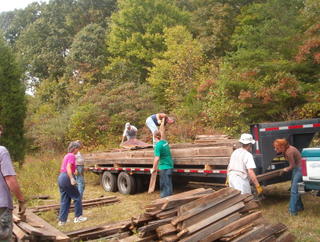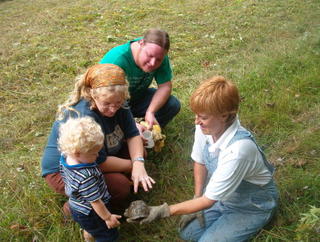A small but fiesty group of would-be (make that "will-be") permaculturists has completed the first half of the curriculum for permaculture design certification. Starting on October 21st and ending on the 29th we spent 8 days at the retreat center learning many aspects of permaculture. We also visited Raccoon Creek twice.
On the first visit the whole class created a swale on a steep hill on the edge of the property and planted a cherry tree. A swale is a trench that (usually) follows the contour of a hill. Its purpose is to trap water running downhill and hold it while it seeps into the hillside rather than running quickly off the hill and likely taking some top soil with it.
The soil removed from the trench is piled on the downhill side so the trench will hold more of the runoff. Over the next hours or days after a rain fall or as a result of snow melt, the captured water will seep into the ground below the swale. Gravity will cause the water to move under the swale and downhill. Over time, the soil below and downhill from the swale will retain much of the moisture making the hillside much better at supporting vegetation.
The cherry tree was planted on the downhill side of the swale. The swale was dug a bit deeper at the tree to catch a bit more water. We also nearly covered the small tree with brush to protect it from browsers, namely deer.
On our second visit, three of us took a close look at the strip of land next to the power line which is Raccoon Creek Community's west boundary. There is a fifty foot easement on each side of the property line demarked by a barbed wire fence and the power line runs above it.
The assigment: How can the power line easement best be used? Develop a plan for improving the land and making it as productive as it can be.
We walked the length of it and found parts of the hill too steep to use, the wetland area ripe for developing, multiple eroded areas where a well pastured field drains across the easement into our woods, and a serious erosion problem at the creek on the southern end.
The entire plan had to be developed in about 3 hours, including the tour, travel each way, and drawing up the plan. Obviously, more detail would be needed later, but we took to the assignment enthusiastically. Here are our recommendations:
For the hillside: a few more swales and eventually a few terraces on the steepest side, the west. As the swales are dug, trees and companion plants would be placed along and between them. Further, we should make the tree line crenulated, that is, rippled, uneven, winding, so that more edge is created between the mowed and the untouched areas.
For the wetland: creation of chanampas -fingers of gardens protruding into a water body that are raised above the water using the soil removed from the wetland. Each of the "fingers" would have a path through the middle to allow for planting and harvesting. Along the width of the wetland area, their number would determine their width, or vice versa, and whether the path through each would be simple and straight or connect a series of "keyholes" that would enlarge the reachable area on each peninsula.
For the eroded areas: begin to slow the erosion by filling in the young gullies with fallen wood, rocks, whatever is nearby. Over time, water flow from the uphill neighbor's pasture will cause nature to fill in around the debris and make the edge along the trees more smooth. This will slow the runoff and cause it to flow into the woods along a longer edge.
For the creek bank: first, raise a ten foot long area at the base of the hill about three feet to cause the runoff to flow through the woods rather than straight into the creek. Next, plant the existing bank with whatever plants will best hold the remaining soil and absorbe the remaining flow.
Finally, along the entire length of the right-of-way we would define a path for walking and make sure it is built as necessary so it will not cause erosion on its own.
Our instructors added a few suggestions. Most significant of these was to take out a few more trees to create some micro climates along the wood's edge and to add some smaller plants along the tree line, if possible, (need to negotiate with the power company) to soften the edge between the mowed right-of-way and the treeline. The power company has trimmed the trees at almost exactly 50 feet from the center line, from the bottom of the tree all the way to the very top! They did not even make healthy cuts, with branches lopped off at fifty feet regardless of how much branch was left protruding from the tree. We hope we can take responsibility for maintenance of the right-of-way in the future.
These poor cuts should be repaired by cutting all the way back to the trunk of each tree, at least as far up the trees as we can get without the large equipment the power company uses.
(A few pictures coming soon.)





